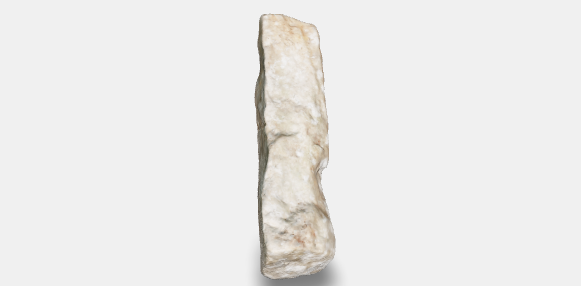Weighting bar with a parallelepiped-trapezoid profile.
It belongs to a class of wooden anchors with a weighting made of lead. In this type, the lead was cast in two wooden cases that were part of an anchor made of the same material.
According to Associazione Kodros, the authors of this discovery, this type of artefact was found in many specimens in the maritime area of Monasterace; most of the times, both arms were discovered not far away from each other. In this case, despite the intense research, only one arm was found.
In this bar there are two through-holes, transversal to its body, put at the same distance of 27/28 cm from the ends, nearly in the median axis, where two iron pegs are clearly visibile. They might be interpreted as two blocking elements used to immobilise the molten lead in the wooden case. The other opposite holes on lateral surfaces probably had the same function; one of them, the one with a square section, probably hosted a fixing nail.
An extrapolation would suggest that the entire anchor should have weighed approximately 150 kg. This is certainly the heaviest anchor found in the area so far.
Can be compared with similar bars found in Lipari (1) and Filicudi (2).
The artefact does not show signs of biological degradation.
1ALBORE LIVADIE 1986, p. 35, figs. 11 and 12b (Lipari, inv. 12606, length cm 77).
2CAVALIER 1986, p. 85, fig. 82d (Filicudi, inv. 12636 a,b. Length 70 cm, weight 70 and 80 kg.
REFERENCES
Albore Livadie C., Discariche e Relitti in Mari Eoliani: Lipari, Vulcano, Panarea, Basiluzzo, Salina, Filicudi, in collaborazione con Cavalier M. e Bernabò Brea L., in Bollettino d’Arte, Archeologia Subacquea 2, Roma, 1986, pp. 27-100.
Cavalier M. 1986, Discariche e Relitti in Mari Eoliani: Lipari, Vulcano, Panarea, Basiluzzo, Salina, Filicudi, in collaborazione con Albore Livadie C. e Bernabò Brea L., in Bollettino d’Arte, Archeologia Subacquea 2, Roma, 1986, pp. 27-100.



